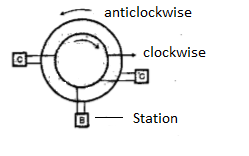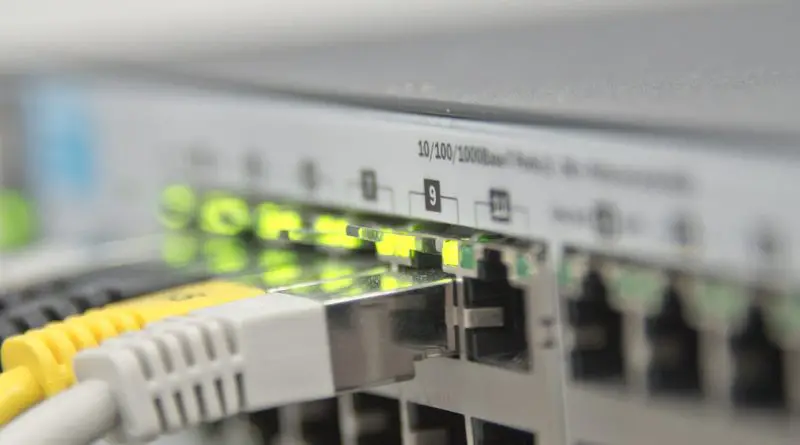What Is Fiber Distributed Data Interface ( FDDl ) In Data Transmission ?
We have seen the IEEE and ethernet frame in the last posts . Now the Fiber Distributed Data Interface (FDDI) is a high-performance fiber optic token ring. It is similar to 802.5 (already seen in the last post) except the difference that FDDI uses the optical fiber cable and not coaxial or twisted pair cables.
Fast Ethernet was designed to compete with LAN protocols such as FDDI or Fiber Channel (or Fibre Channel, as it is sometimes spelled). Fast Ethernet is compatible with Standard Ethernet, but it can transmit data 10 times faster at a rate of 100 Mbps .
FDDI cabling consists of two fiber rings, one transmitting clockwise and the other transmitting counterclockwise as shown below :

If anyone of them breaks down, the other can be used as a backup. If both break at the same point, due to a fire or other accident in cable duct, the two rings can be then joined into a single ring.
The dual ring topology basically uses a second (auxiliary) ring which operates in the reverse direction(s shown above) compared with the main ring. The second ring is only for emergencies (like a spare tire for a car).
If one of the links in the main ring suddenly fails, the system automatically combines the two rings to form a temporary ring. After the failed link is restored, the auxiliary ring again becomes idle .
Each station contains relays that can be used to join the two rings or bypass the station if some station problems occurs.
Furthermore, for this topology to work, each station needs to have two separate transmitter ports and two receiver ports. The common high-speed Token Ring networks called FDDI (Fiber Distributed Data Interface) and CDDI (Copper Distributed Data Interface) use this topology.
To transmit any data, a station must first capture the token. Then it transmits a frame and removes it when it comes around again, one more difference between FDDI and 802.5 standard is that in 802.5 , a station may not generate a new token until its frame has gone all the way around and come back.

As we know there is dual ring, in FDDI because of the expenses of the dual-ring configuration, FDDI allows nodes to attach to the network by means of a single cable.
Such nodes are called single attachment stations, (SAS) their dual-connected counterparts are called, dual attachment stations (DAS). A concentrator is used to attach several SAS to the dual ring.
FDDI defines two classes of traffic i.e. synchronous and asynchronous. When a node takes hold of a token, it is allowed to send synchronous data, without regard for whether the token is early or late.
In contrast, a node can send asynchronous traffic only when the token is early. Synchronous FDDI means that the traffic is delay sensitive, sending voice or video as synchronous traffic. Asynchronous means that the application is more interested in throughput than delay.
A file transfer application would be asynchronous traffic. The FDDI mechanism for ensuring that a valid token is always in circulation are also different from those in 802.5 format.
First, all nodes on an FDDI ring , monitor the ring to be sure that the token has not been lost. Observe that in a correctly functioning ring , each node should see a valid transmission in the form of either a data frame or the token.
The greatest idle time between valid transmissions that a given node should experience is equal to the ring latency plus the time it takes to transmit a full-frame. The FDDI MAC protocol uses three timers. The token holding timer determines how long a station may continue to transmit once it has acquired the token.
This timer prevents a station from hogging the ring forever. The token rotation timer is restarted every time the token is seen. If this timer expires, it means that the token has not been sighted for too long on interval, it has been lost, so the token recovery procedure is initiated.
Finally, the valid transmission timer is used to time out and recover from certain transient ring errors.
FDDI also has priority algorithm. It determines which priority classes may transmit on a given token pass. If the particular token is ahead of schedule, all priorities may transmit, but if it is behind schedule, only the highest ones may send.
FDDI Frame Format

FDDI uses 4B5B encoding instead of manchester symbols in the start and end of frame markers. The other difference is the presence of a bit in the header to distinguish synchronous from asynchronous traffic and the lack of access control bits of 802.5 standard .
Stay tuned for more interesting stuff in this series related to data link layer in osi model.

Aric is a tech enthusiast , who love to write about the tech related products and ‘How To’ blogs . IT Engineer by profession , right now working in the Automation field in a Software product company . The other hobbies includes singing , trekking and writing blogs .



